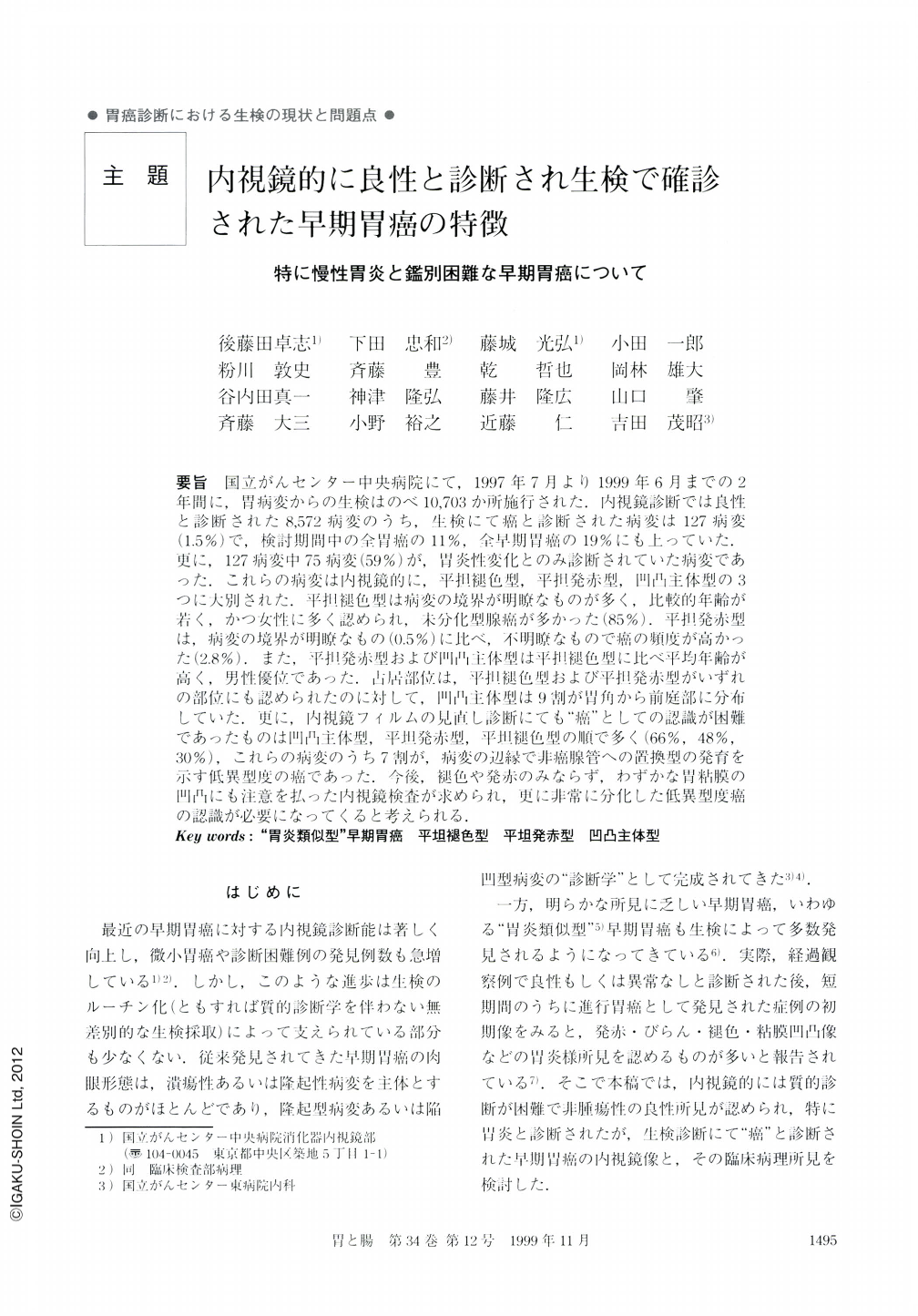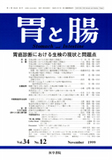Japanese
English
- 有料閲覧
- Abstract 文献概要
- 1ページ目 Look Inside
- サイト内被引用 Cited by
要旨 国立がんセンター中央病院にて,1997年7月より1999年6月までの2年間に,胃病変からの生検はのべ10,703か所施行された.内視鏡診断では良性と診断された8,572病変のうち,生検にて癌と診断された病変は127病変(1.5%)で,検討期間中の全胃癌の11%,全早期胃癌の19%にも上っていた.更に,127病変中75病変(59%)が,胃炎性変化とのみ診断されていた病変であった.これらの病変は内視鏡的に,平担褪色型,平担発赤型,凹凸主体型の3つに大別された.平担褪色型は病変の境界が明瞭なものが多く,比較的年齢が若く,かつ女性に多く認められ,未分化型腺癌が多かった(85%).平担発赤型は,病変の境界が明瞭なもの(0.5%)に比べ,不明瞭なもので癌の頻度が高かった(2.8%).また,平担発赤型および凹凸主体型は平担褪色型に比べ平均年齢が高く,男性優位であった.占居部位は,平坦褪色型および平担発赤型がいずれの部位にも認められたのに対して,凹凸主体型は9割が胃角から前庭部に分布していた.更に,内視鏡フィルムの見直し診断にても“癌”としての認識が困難であったものは凹凸主体型,平川発赤型,平川褪色型の順で多く(66%,48%,30%),これらの病変のうち7割が,病変の辺縁で非癌腺管への置換型の発育を示す低異型度の癌であった.今後,褪色や発赤のみならず,わずかな胃粘膜の凹凸にも注意を払った内視鏡検査が求められ,更に非常に分化した低異型度癌の認識が必要になってくると考えられる.
Recently, the number of biopsies taken from the stomach has been increasing. This method is useful technique for the diagnosis of cancers with little malignant appearance. On the other hand, in our retrospective study, the endoscopic appearance of the original lesion of gastric cancer which had grown from early to advanced cancer in a short period of time was occasionally similar to gastritis-like findings, such as discoloration, reddness and/or granular appearance. To clarify the macroscopic features of gastritis-like cancer, we investigated patients undergoing endoscopic examination during the period between July, 1997 and June, 1999 at the National Cancer Center Hospital. During this period, 10,703 biopsy specimens were obtained from the patients. Of 8,572 lesions which were endoscopically diagnosed as benign, 127 (1.5%) were histologically confirmed as malignant. Of these 127 lesions, 75 (59%) showed gastritis-like findings with little malignant appearance. These gastritis-like cancers accounted for 11% of all early gastric cancers in the period of the time mentioned.
The endoscopic appearance of 75 gastritis-like cancers, the subjects of this study, were divided into the following three groups; flat discolored, flat reddish and granular types, according to the surface structure and color of the lesion. Histological grading of the cancer was divided into low- or high-grade atypia.
In the flat discolored type, cancerous lesions with a margin were seen in young females, and the histological type was usually undifferentiated carcinoma. In the flat reddish type, the lesions with an unclear margin showed a high incidence of carcinoma (2.8%), in contrast with those with a clear margin (0.5%). Also, 48% of these were difficult to diagnose as cancer by review of the endoscopic films. In the granular type, the lesions were generally located in the distal stomach, and detected in elder males. Moreover, 66% of these were difficult to diagnose as cancer by review of endoscopic films.
Histologically, the incidence of cancer with low-grade atypia in the cancer with little malignant appearance was higher (72%) than the incidence of cancer with apparent cancerous findings (46%) . It was confirmed that there was a higher rate of cancer occurrence (66%) among lesions with little malignant appearance, than among the other two groups (48% and 30%) .
These results suggest that the cancers with low-grade atypia are difficult to diagnose as cancer by conventional endoscopic criteria, because these reveal lateral growth by replacement in non-cancerous gland. Attention to slight mucosal change and recognition of cancers with low-grade atypia is necessary during endoscopic examination.

Copyright © 1999, Igaku-Shoin Ltd. All rights reserved.


